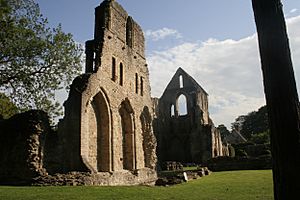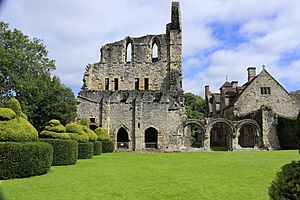Wenlock Priory facts for kids
Wenlock Priory, or St Milburga's Priory, is a ruined 12th century monastery, located in Much Wenlock, Shropshire, at . The foundation was a part of the Cluniac order, which was refounded in 1079 and 1082, on the site of an earlier 7th century monastery, by Roger de Montgomery. It is thought to be the final resting place of Saint Milburga, whose bones were reputedly discovered during restoration work in 1101.
Parts of the building became a house later known as "Wenlock Abbey", which is privately owned, but most of Wenlock Priory is open to the public under the care of English Heritage and is used mostly for recreational purposes. The grounds have a collection of topiary.
History
Early history
Merewalh, King of the Magonsaete founded the original Anglo-Saxon monastery here circa 680 and Merewalh's daughter quickly became its abbess, and was later canonised. After her death circa 727, however, little is historically known of the monastery until the Norman Conquest. It is known that the priory was inhabited by monks until after the Norman conquest. In the 12th century, the abbey was replaced by a Cluniac priory for men.
Just after 1200 Prior Humbert obtained various grants from King Henry III, an occasional guest at the Priory, who imported his own wines to be stored there. The grants enabled the building of a newer, larger church.
Following the reformation of the monastery, in the early 14th century, the priory church was lavishly and completely rebuilt, and today considerable remains are left of the 350-foot-long church (110 m), including the north and south transept and the nave.
Around the Priory, the town of Much Wenlock was formed. The town is made up of a small network of intricate, narrow streets lined with timber-framed black and white buildings. Within the town is the well of St Milburga of Wenlock which was said to have cured sight impairments and helped Victorian women find a suitor.
Dissolution
Following the dissolution in 1540, several buildings, including the late 15th-century Prior's House, were converted into a private residence later known as "Wenlock Abbey".




